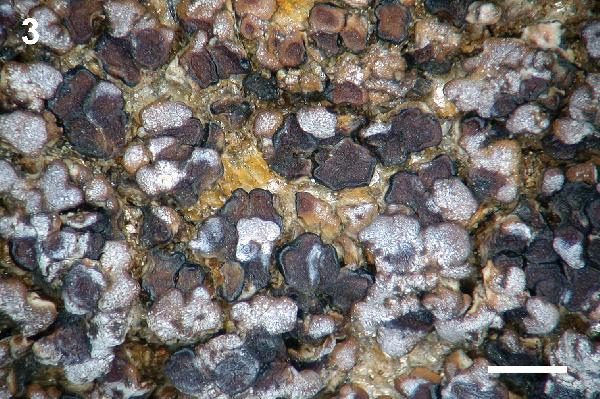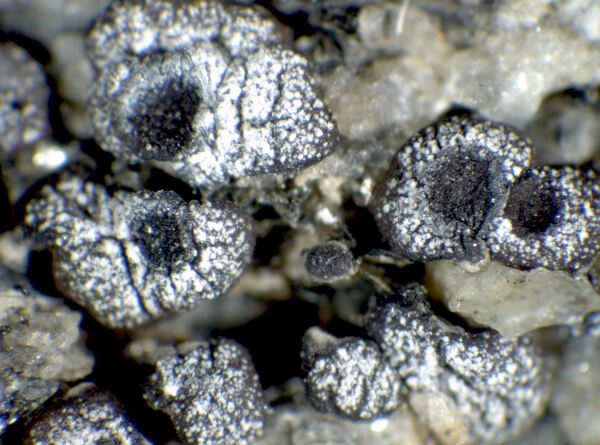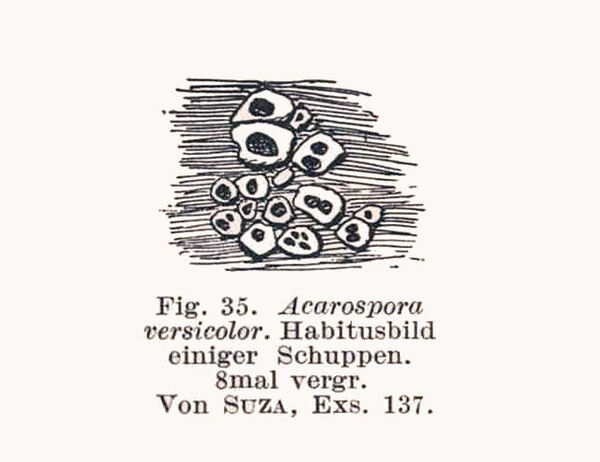Acarospora versicolor Bagl. & Carestia
Comm. Soc. Critt. Ital., 1, 5: 440, 1864.
Synonyms: Acarospora cineracea (Nyl.) Hue; Acarospora miskolensis H. Magn.
Description: Thallus crustose, episubstratic, areolate, the areoles 0.5-1(-2) mm wide, 0.3-0.5 mm thick, usually flat, smooth, dispersed or contiguous, grey to brown, partially bluish white-pruinose, the margins most often brown. Epicortex thin or lacking; cortex 20-40 µm thick, the cells mostly 3-4 µm wide; algal layer continuous, 70-150 µm thick; medulla white, up to 0.3 µm thick, I-. Apothecia immersed, 0.1-0.4 mm across, with a black (brown when wet), concave disc, and a thin thalline margin. Proper exciple prosoplectenchymatous, I-, 5–20 µm wide or widening around the disc up to 70 µm, forming a black excipular ring around the disc; epithecium brown, c. 10 µm high; hymenium colourless, 100-120 µm high, the hymenial gel hemiamyloid, K/I+ light blue fading to light red; paraphyses 1.5-2 µm thick at mid-level, the apical cells hardly swollen or sometimes up to 4-5 µm wide; subhymenium 20-60 µm high, colourless or faintly golden yellow, I+ blue; hypothecium narrow, usually c. 10 µm high. Asci 100-200-spored, cylindrical to narrowly clavate, the apical dome K/I-, 70–100 x 10–20(x30) µm. Ascospores 1-celled, hyaline, ellipsoid, 3-5 x 1.5-2 µm. Photobiont chlorococcoid. Spot tests: cortex and medulla K-, C-, KC-, P-, UV-. Chemistry: without lichen substances.
Growth form: Crustose
Substrata: rocks
Photobiont: green algae other than Trentepohlia
Reproductive strategy: mainly sexual
Subcontinental: restricted to areas with a dry-subcontinental climate (e.g. dry Alpine valleys, parts of Mediterranean Italy)
Commonnes-rarity: (info)
Alpine belt: absent
Subalpine belt: absent
Montane belt: extremely rare
Dry submediterranean belt: very rare
Humid submediterranean belt: extremely rare
Padanian area: absent
pH of the substrata:
1 2 3 4 5
Solar irradiation:
1 2 3 4 5
Aridity:
1 2 3 4 5
Eutrophication:
1 2 3 4 5
Poleotolerance:
0 1 2 3
Altitudinal distribution:
1 2 3 4 5 6
Rarity
absent
extremely rare
very rare
rare
rather rare
rather common
common
very common
extremely common
Loading data...
Occurrence data
Predictive map

Source: Westberg M, Timdal E, Asplund J, Bendiksby M, Haugan R, Jonsson F, Larsson P, Odelvik G, Wedin M, Millanes AM (2015) New records of lichenized and lichenicolous fungi in Scandinavia. MycoKeys 11: 33-61. - CC BY-4.0
NORWAY. Buskerud: Hole, west side of the island Storøya, 60,04685°N, 10,2376°E. 8 June 2008, Westberg 08-092 (S F268460)
Scale: 1 mm.
Growth form: Crustose
Substrata: rocks
Photobiont: green algae other than Trentepohlia
Reproductive strategy: mainly sexual
Subcontinental: restricted to areas with a dry-subcontinental climate (e.g. dry Alpine valleys, parts of Mediterranean Italy)
Commonnes-rarity: (info)
Alpine belt: absent
Subalpine belt: absent
Montane belt: extremely rare
Dry submediterranean belt: very rare
Humid submediterranean belt: extremely rare
Padanian area: absent
pH of the substrata:
| 1 | 2 | 3 | 4 | 5 |
Solar irradiation:
| 1 | 2 | 3 | 4 | 5 |
Aridity:
| 1 | 2 | 3 | 4 | 5 |
Eutrophication:
| 1 | 2 | 3 | 4 | 5 |
Poleotolerance:
| 0 | 1 | 2 | 3 |
Altitudinal distribution:
| 1 | 2 | 3 | 4 | 5 | 6 |
Rarity
absent
extremely rare
very rare
rare
rather rare
rather common
common
very common
extremely common
Loading data...
Occurrence data
Predictive map









